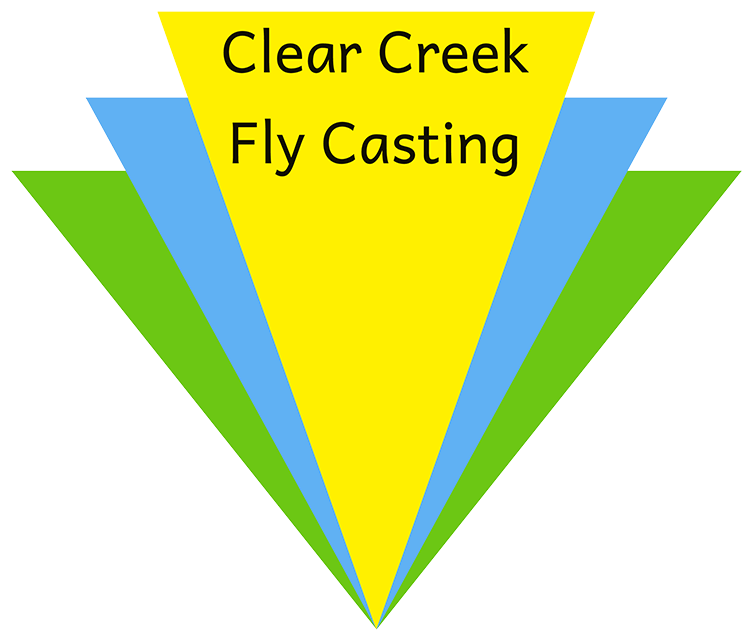


Welcome everyone to the Summer newsletter. Hope you are all well and getting some fishing in. This newsletter is for you, so please send in your suggestions for topics to jonathan@clearcreekflycasting.com. I resumed teaching in person 5/17, and since then business has been slow. It is dry fly season, so if you need tuning up on accuracy or presentation casts, let me know. I also am teaching groups and recently did some clinics with Colorado Women Fly Fishers on 6/24. Contact me to work with your group today!

I now offer remote video casting instruction. Contact me for more details! You take the video, send it to me, I analyze it and discuss it with you by phone or video conference. If you don’t have a certified instructor nearby or want to work specifically with me, this is a way to do it! See my website for more details. See my website under Lessons/Presentations at www.clearcreekflycasting.com.
How do I grip the fly rod?
Like so many things in life the answer is “it depends.” There are advantages and disadvantages for each technique rather than a right or wrong answer, although there are 2 grips to avoid. I will share with you my approach which has served me and my students well. Experiment with grips in different situations and see what works best for you.
Interestingly, students often grip the rod with a very commonly used and reasonable approach, which is the “thumb on top grip.” When I see this, I don’t even discuss grip (unless I see white knuckles)! The student is already using a useful technique, so why clutter the lesson with more information? If I think a different technique would suit better, we discuss this as an option with clear instruction as to why. The best grip is the one that works the best for you and keep an open mind as different techniques may suit different situations.
This brings us to advantages and disadvantages of different grips, and brief mention of grips to avoid at the end.
Thumb on top: This grip is a great place to start and is a natural way of holding the rod for many. It is a powerful grip as the thumb is the most powerful digit in the hand. A disadvantage is that it can allow/encourage the most wrist movement; I sometimes move wristy casters away form this grip. I often use it for casting distance, heavy rods, and rigs as well as roll cast and single hand Spey.
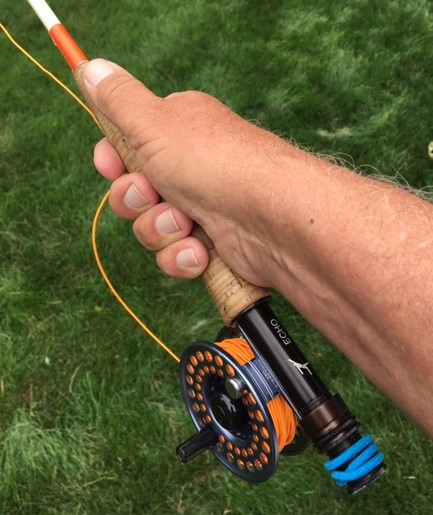
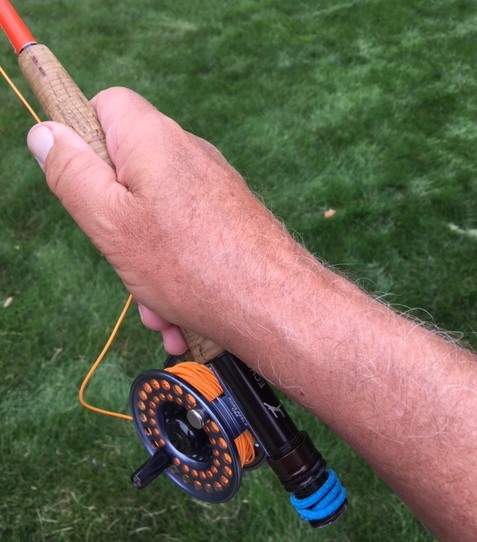
The “V” grip: This slight variation of thumb on top can often be just enough to reduce or discourage wrist motion. The thumb is now on the caster’s side of the grip, the index finger is on the opposite side wrapped around the cork, and the “V” of the space in between is on top of the grip. Although a bit less powerful than thumb on top, there is plenty of power for most casts. For some it is uncomfortable, especially if the grip is too big for hand size. I don’t use this grip much anymore since I learned the Borger grip, but that’s just me!
The Finger on Top Grip: Few students migrate to this immediately. I usually see it in students who are following an example (“This is the way my Dad did it”) or were taught this. Its advantages are that it discourages wrist movement the most of all the grips, and many like it for accuracy, especially close in. A disadvantage is that it can be fatiguing as it relies on less powerful muscles. I often use this grip for targets at 20-30 ft.
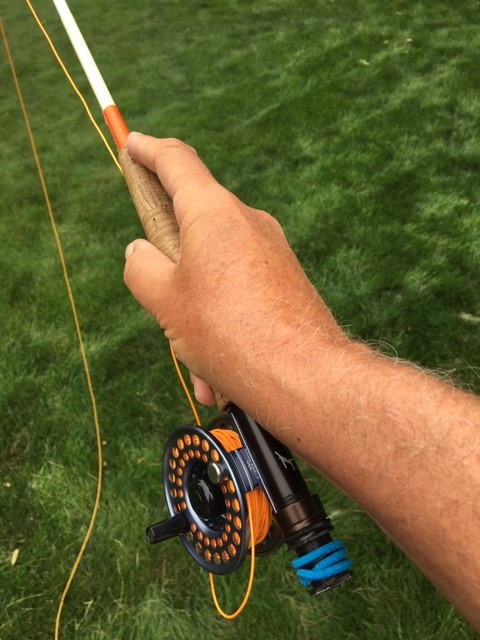

The Borger Grip: This grip was popularized by Gary Borger and his son, Jason. It looks like the V grip, but there are significant functional differences. First, and foremost, the hand is moved back on the cork so that the fleshy part near the wrist is at the bottom end of the cork, even on the reel seat. The thumb is on the caster’s side of the cork, and the index finger is extended straight along the other side of the cork. Its advantages are: the hand is closer to the end of the rod giving the caster more feel of what’s happening; wrist movement is discouraged by the extended index finger and the hand being closer to the mass of the reel, and the extended index finger mirrors the motion of the rod. This has become my default trout fishing grip. I admit I did not care for it at first, but quickly felt the advantages in terms of rod action. Keeping the index finger travelling in a single plane helped tracking issues and longer distance accuracy.
Avoid the Death Grip: When I see white knuckles or clients shaking cramps out of their hand, I say “relax.” The caster needs to grip the rod just enough to keep it in hand through the casting stroke. Imagine that the rod is a bird. You need to grip just enough not to let the bird go, but don’t crush it! I should be able to easily pull the rod out of the client’s hand. (Note the white fingernail beds and red index finger tip in the photo from squeezing!)
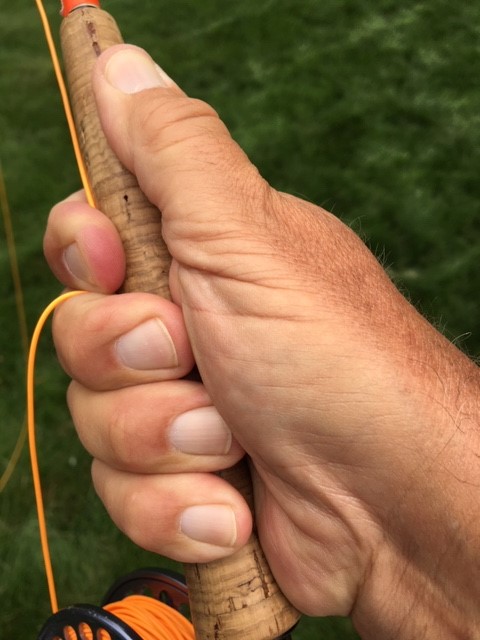
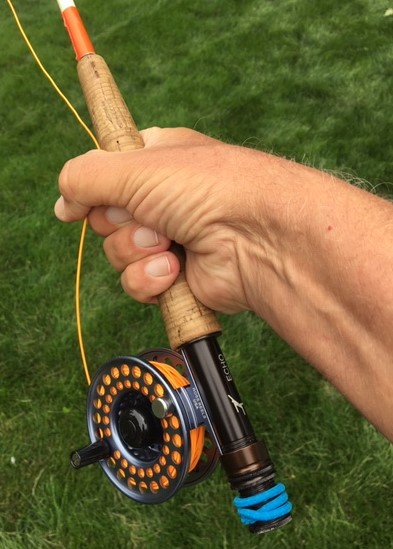
Avoid the Suitcase Grip: The only advantage of this grip is that it is hard to drop the rod; I think it actually encourages the Death Grip. The only students I allow to use this are small children when it is the only way they can hang on to the rod. In that setting, I usually have them use two hands
TEACHING PEARL
Tell your students what and how to practice with a clear goal.
In the last installment, I encouraged correcting one thing at a time, and then end by telling the student what to practice. Let’s continue with that same student. She needs to get consistent improvement in the back cast. At the end of the lesson give her a drill to do to consolidate and cement the gains. Here is a suggestion: make her look at her back and forward casts. She will not be able to fix what she cannot see. Make it easy for her to look at them by casting sidearm (horizontal or near horizontal plane) with her body turned to the side. Instruct that the head should turn to look at the back cast and then turn to look at the forward cast until the improved back cast becomes second nature. Start by making a back cast and letting it fall. Tell her what the goal is: when she sees the “foundation loop” (4 ft. or less top to bottom leg with a relatively straight top leg) she is doing it right. Have her do it with you to make certain she can see the loop and understands the overall exercise. Then she can do sidearm false casting while maintaining good loops front and back. Ask her to do this for 30 min. 3X/week until the next lesson. Even if there is not a second lesson, her casting will still improve because of a better back cast!
Spey rods, Spey casts, Switch rods, Switch Casts…what does it all mean?
Those just starting to explore the two-hand casting world find it confusing because…it is! I will try to define these terms to bring some clarity. If you are contemplating a purchase and are confused by all the line weights, rod weights and other jargon, contact me at jonathan@clearcreekflycasting.com so I can help!!
Spey rods: These are rods meant to be cast with 2 hands only, one above and one below the reel. They are at least 10 ft. and often longer. A 7 wt. Spey rod is about the equivalent of a 9-10 wt. single hand rod in terms of species being fished. For trout in Colorado, a 3, 4 or 5 wt. trout Spey would be my choice. The bottom hand supplies power and the top hand brakes and steers. The power application is about 70% bottom hand and 30% top hand. Spey rod design is such that the middle and butt of the rod flex and straighten more than single hand rods resulting in a lot of power coming from here.
Spey Casts: These are just casts that can be done with single or two hand rods. They are used for change of direction, such as line/leader washed downstream to across stream. Beside change in direction they can be used where no or little back cast room is available. Significant distance can be achieved with good technique. Single handers can use these for all types of fishing, with swinging streamers and wets and casting nymph rigs the most common applications. Examples are Single Spey, Double Spey, Snake Roll, and Snap T. I love to swing wets and streamers both single and two hand, so I use Spey casts quite a bit.
Switch Rods: As the name implies, the rod can be used as a two hander, but the angler may “switch” to single hand use. The rod action is closer to single hand rod design with progressive action. Rod weight is usually designated as equivalent to single hand world in terms of species you are chasing but be careful with line choice. In Colorado, someone that likes fishing larger rivers, swinging streamers and wets, but also enjoys indicator nymphing would find such a rod versatile.
Switch Casts: This should really read switch cast. The switch cast is just a dynamic roll cast. The D loop is moving. There is no change in direction, therefore it is technically not a Spey cast. Its use is primarily for longer roll casts. Also, the motion of the switch cast is what is done at the end of all Spey casts, making the switch motion a part of a Spey cast, but not the whole cast.
Looking for past newsletters? Here you go: